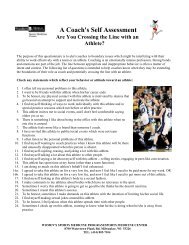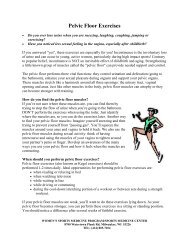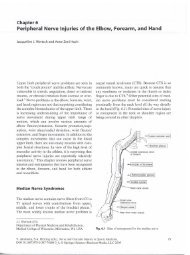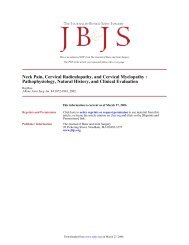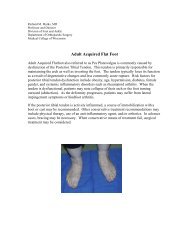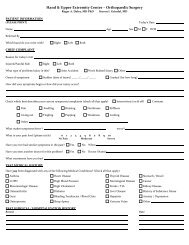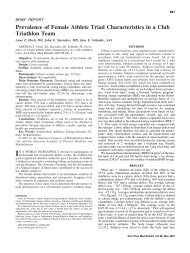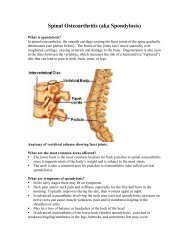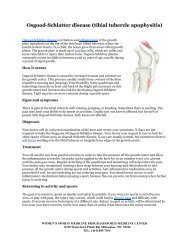Menstrual Cycle Data Sheet
Menstrual Cycle Data Sheet
Menstrual Cycle Data Sheet
Create successful ePaper yourself
Turn your PDF publications into a flip-book with our unique Google optimized e-Paper software.
MENSTRUAL CYCLE DATA<br />
Most girls and women derive significant health benefits from regular physical activity and can achieve<br />
the same training effects as men which include decrease blood pressure, lower heart rate, improved<br />
aerobic capacity and decreased body fat. These changes protect against heart disease. In addition,<br />
weight bearing exercise promotes strong and healthy bones.<br />
From 1972 to 2000 there has been an 800% INCREASE in the number of women of all ages<br />
participating in sports, both at recreational and competitive levels.<br />
Athletes, parents, coaches and physicians should be aware<br />
that girls and women who exercise regularly and don’t<br />
eat properly have the potential for menstrual cycle<br />
dysfunction.<br />
Sports that emphasize leanness, endurance sports,<br />
and appearance sports have a higher percentage of<br />
athletes with menstrual disorders.<br />
Normal <strong>Menstrual</strong> Function<br />
Onset of first menstrual cycle (menarche) is generally from age 11.5 to 12.5<br />
Development of secondary sex characteristics usually occurs one or two years earlier<br />
(pubic hair and breast development)<br />
Normal cycles are between 21-35 days, average 28days.<br />
<strong>Menstrual</strong> flow lasts 3-5 days<br />
Primary Amenorrhea<br />
NO period by age 16 or later<br />
No development of secondary sex<br />
characteristics by age 14<br />
Secondary Amenorrhea<br />
NO period for 3 Months IN A ROW after<br />
menstrual periods have started<br />
Oligomenorrhea<br />
3-6 menstrual cycles per year<br />
Interval between cycles greater than 35 days<br />
Dysmenorrhea is the term used for a menstrual cycle with heavy flow and painful<br />
cramps. Scientists believe that regular exercise may be beneficial in reducing these<br />
symptoms.
How common is amenorrhea?<br />
General population/Non-Athletes: 2-5%%<br />
Athletic women: 1-44%<br />
Consequences of Athletic Associated Amenorrhea<br />
Osteoporosis<br />
Premature vascular dysfunction<br />
Infertility<br />
Amenorrhea is associated with a deficiency of estrogen (similar to women in menopause)<br />
Estrogen is needed to absorb calcium and deposit it into bone. Lack of estrogen can cause bone<br />
demineralization leading to an increased risk of stress and other fractures. Athletic women may<br />
have other menstrual dysfunctions such as infertility that only become evident with difficulty<br />
becoming pregnant.<br />
60%<br />
50%<br />
40%<br />
30%<br />
20%<br />
10%<br />
0%<br />
Amenorrhea<br />
59%<br />
26%<br />
12%<br />
Ballet Run Swim<br />
EXERCISE-ASSOCIATED AMENORRHEA IS DIAGNOSED WHEN OTHER MEDICAL<br />
CONDITIONS ARE RULED OUT.<br />
Major Causes<br />
Energy Deficit (Calories OUT > Calories IN)<br />
Disordered eating Restrictive eating<br />
Emotional Stress<br />
Low Fat/ Low Carb intake<br />
Diagnostic Plan may include:<br />
Laboratory Analysis<br />
Dietitian Consultation with<br />
3-Day food record<br />
Resting Energy Expenditure<br />
Meal Planning<br />
Bone Densitometry<br />
Psychological and emotional factors as well as stress can have an effect on menstrual function<br />
In some sports, coaches and judges in addition to parents, place an overemphasis on body<br />
composition and percent body fat creating an unhealthy preoccupation with body image.<br />
Dr. Anne Z. Hoch<br />
Director<br />
Women’s Sports Medicine Program<br />
(414) 805-7461



